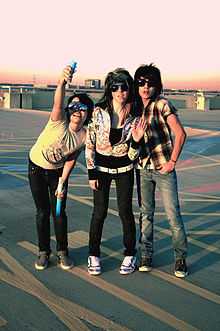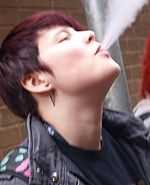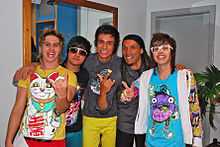Scene (subculture)

The scene subculture is a contemporary subculture which has been common in the United States, Europe, Asia, and Latin America from the late 2000s until the mid 2010s. People (most often in their teens to 20s) involved in this style are called "scene people," "scene kids," "trendies" or sometimes "scenesters"[1] in the US, "moshers," "chavmos," or "chemos" in the UK, "coloridos" in Latin America, and "shamate" in China.[2]
History and evolution of fashion
Origins (late 1990s to early 2000s)

The scene subculture began in United Kingdom during the late 1990s and early 2000s when some members of the chav[3] subculture began to experiment with alternative fashion,[4] and took fashionable characteristics of indie pop, emo, rave music, and punk fashions.[5] The fashion originally included typical pop punk and skater clothing like tripp pants, stripes, tartan, spiky hair, Chucks, Vans, and trucker hats derived from grunge and skate punk fashion. Older punks and skaters, however, looked down on these young trendies (as they were then called) for their inauthenticity and inability to skate.[6]
Due to the internet, especially fashion and makeup tutorials on YouTube, scene fashion had spread to America and Australia by the mid-2000s.[7] Typical clothing of this period included miniskirts, striped tights, hoodies, androgynous hairstyles and skinny jeans. Before 2005, these outfits were in predominantly darker colors like black or grey, but accented with the occasional brightly colored garment.[4]
The name was originally derived from "scene queen", a derogatory term within the 1970s glam rock scene for any heterosexual musician who pretended to be gay and later applied to poseurs within the UK goth, heavy metal and punk subcultures.[8] By the 2000s, this term was replaced with "scene kid", later shortened to "scene." It was widely used by members of the American skater subculture to put down younger hangers-on viewed as being more interested in alternative or designer clothes than skateboarding.[9] Later, "scene queen" itself was adopted by leading female members of the modern subculture who were unaware of its original meaning, like supermodel Audrey Kitching.[10]
Evolution (mid–late 2000s to present)


By 2008, the scene subculture had become a common sight in Britain and the US, superseding the earlier emos, goths, skater subculture, and Moshers.[11][12] At this time, the fashion took on anime influences[2] and evolved into androgynous, matted, flat and straight hair sometimes dyed bright colors, drainpipe jeans,[13] cartoon print hoodies, shutter shades, promise rings,[14] checked shirts, and lots of very bright colors.[1] Scene girls often wear thick eyeliner.[1] The fashion was influenced by the fashions of emo, preppy and glam.
Users from Social Network site Myspace started to upload Selfie photos showing hairstyles with dyed hair and spikes, black skinny jeans, heavy silver necklaces, heavy makeup and flashy or black T-Shirts. At first this new trend was attributed to singer and fashion designer Jeffree Star, being considered something original. However, the style was still considered as "unique" and even influenced bands like Black Veil Brides, Falling In Reverse, Blood On The Dance Floor and Escape The Fate.
In Europe and some parts of the United States, in particular California, scene kids incorporated elements of hip-hop, emo, preppy, and indie[15] fashion. During the early 2010s, popular clothings included skinny jeans, trucker hats, Nike shoes, mismatched neon green, fluorescent yellow or hot pink socks worn with sneakers or Sperry Top-Siders boat shoes, 2fer and layered shirts, tees and polos, Vans, Levi's 501 jeans,[16] Dickies shorts, pocket watches,[17] flannel shirts, thin ties, Chucks, Keds, vintage tees,[18] plain tees with contrasting edging, and Vans.[19] Shirts and hoodies with messages such as "cool story bro" or the logos of music such as Blood on the Dance Floor, Brokencyde and Jeffree Star became popular among scene kids.
By 2012, many scene kids had abandoned the cartoon print hoodies, skinny jeans and studded belts in favor of a more hardcore/skate punk look with wifebeaters, plain hoodies, combat boots, Vans, tapered jeans, and stretched earlobe piercings, except in parts of Latin America, like Fortaleza, where late-2000s scene and emo fashion remained common.[20] Short hair replaced the androgynous styles of the late 2000s, with many scene kids opting for messy cropped hair with colors dyed in, or adopting the Hitler Youth haircut associated with indie kids and the contemporary skater subculture.
Controversy and criticism
Scene has often been confused consistently with emo.[1][21] Many people involved in the emo style have accused scene of ripping off emo.[1][21] Music associated with the scene subculture, including Brokencyde and Blood on the Dance Floor,[22][23] received lots of criticism and was subject to major controversies in 2009 and the 2010s. For example, Brokencyde is generally panned by critics. Cracked.com contributor Michael Swaim said the band sounded like "a Slipknot-Cher duet".[24] British comic book writer Warren Ellis considered Brokencyde's "FreaXXX" music video "a near-perfect snapshot of everything that’s shit about this point in the culture".[25] A writer for the Warsaw Business Journal attempted to describe their music: "Imagine an impassioned triceratops mating with a steam turbine, while off to the side Daft Punk and the Bee Gees beat each other to death with skillets and spatulas. Imagine the sound that would make. Just try. BrokeNCYDE is kind of like that, except it also makes you want to jab your thumbs into your eyeballs and gargle acid."[26]
The New Musical Express stated in a review of I'm Not a Fan, But the Kids Like It!, that "even if I caught Prince Harry and Gary Glitter adorned in Nazi regalia defecating through my grandmother’s letterbox I would still consider making them listen to this album too severe a punishment."[27]
August Brown of the Los Angeles Times writes:
"This 'Albucrazy'-based band has done for MySpace emo what some think Soulja Boy did for hip-hop: turn their career into a kind of macro-performance art that exists so far beyond the tropes of irony and sincerity that to ask 'are they kidding?' is like trying to peel an onion to get to a perceived central core that, in the end, does not exist and renders all attempts to reassemble the pieces futile."[28]
Backlash

During the early 2010s, several governments have proposed banning scene and emo fashion as antisocial, and a corrupting foreign influence over the youth.[29] Some Middle Eastern Islamists believe the tight, brightly colored, scene clothing is immodest and, when worn by men, a sign of homosexuality. In Gaza, teenage boys who were wearing skinny jeans have been arrested and beaten by the police, and forced to have their hair cut.[30] Scene and emo girls have also been threatened with jail, because their brightly dyed hair flouts Islamic female dress codes.[31]
Music


Often the scene subculture has been associated with emo, post-hardcore, metalcore, deathcore, electronica, pop punk and indie rock. Some groups and artists in music associated with the scene subculture include X Blake Freeman X, Never Shout Never!, K-oZZ, Brokencyde [32] Blood on the Dance Floor,[33] Dot Dot Curve,[34] 3OH!3, Scene Kidz, Breathe Carolina,[35][36] Jeffree Star, Millionaires, and Design the Skyline.
Much of the Scene's popularity and rise to notability is due to Scene music uploaded to YouTube. Music videos, lyric videos, and sometimes fan uploaded videos, helped bring the Scene to what it is today. Either because the songs were loved or hated, they were shared, which helped bring it into the public's eyes. Songs such as Dot Dot Curve's "Scene Kid", X Blake Freeman X's "The Scene Is Dying", and Geoffrey Paris' "Scene Kids" are examples of songs that brought the Scene to what it is today.
In Latin America, scene clothing and androgynous hairstyles are often worn by teenage fans of bubblegum pop groups like Restart.[37] In response to the (sometimes violent) backlash against emo kids, especially in Mexico, teenagers of both genders began wearing bright colors and cartoon prints, rather than black.[38] From the late 2000s until the mid 2010s these fans, known as Coloridos,[39] were a common sight in northern Brazilian towns like Fortaleza.[40][41] By 2015, however, bands and fans alike had moved away from the bright colors in favor of a darker look inspired by 1990s grunge and the 2010s hipster subculture.[42]
In other media
- Wyldstyle, a character from the 2014 Lego movie,[43] wears a typical brightly colored pink and blue scene hoodie. Her hair, with long bangs, electric blue streaks, and small ponytail, was often sported by scene and alternative[44] girls during the early 2010s.[45]
- Some teenagers wearing identifiably scene clothes and hair with brightly dyed bangs appear as background extras in the Japanese segments of Babel.
- Scene, pop-punk and emo kids are unpopular among the street punk and metalhead subcultures for allegedly commercialising the more kitsch aspects of alternative fashion, and being more interested in the look than the music or lifestyle. In 2008, Steel Panther wrote a protest song called Death to All but Metal[46] mocking scene kids' music choice,[47] and in 1998 Sloppy Seconds compared the so-called "trendies" to kewpie dolls for their lack of individuality.[48]
See also
- Poseur
- Teenybopper
- Babybat
- Hipster subculture
- 2000s in fashion
References
- ↑ 1.0 1.1 1.2 1.3 1.4 "Inside the clash of the teen subcultures - National". Smh.com.au. 2008-03-29. Retrieved 2015-04-06.
- ↑ 2.0 2.1 "Meet Shamate, China's Most Hated Subculture - BuzzFeed News". Buzzfeed.com. 2015-03-29. Retrieved 2015-04-06.
- ↑ "Emo vs Scene - Difference and Comparison". Diffen.com. Retrieved 2015-04-06.
- ↑ 4.0 4.1 "Finding Emos ...and goths, moshers and scene kids". Yorkshireeveningpost.co.uk. 2007-03-09. Retrieved 2015-04-06.
- ↑ Anton Djamoos (2008-03-29). "The Scene Kid Subculture vs. Emos - News Article". AbsolutePunk.net. Retrieved 2015-04-06.
- ↑ To the Extreme: Alternative Sports, Inside and Out - Google Books. Books.google.co.uk. Retrieved 2015-04-06.
- ↑ Scene Kids will destroy democracy, 22 January 2009
- ↑ Freddie Mercury and Queen, 31 Jul 2014
- ↑ Shreddin' it Up: Re-thinking "youth" Through the Logics of Learning and ... - Robert Anthony Petrone - Google Books. Books.google.co.uk. Retrieved 2015-04-06.
- ↑ Kamphausen, Kathleen (2009-04-06). "Audrey Kitching - Fashion Disaster". Cosmopolitan.com. Retrieved 2015-04-06.
- ↑ "Switch". BBC. Retrieved 30 November 2011.
- ↑ New Haights: Scene kids ought to receive a crash course on their group (19 June 2007)
- ↑ "Apparel". Hottopic.com. Retrieved 30 November 2011.
- ↑ A B Haenfler, Ross (2006). Straight Edge: Hardcore Punk, Clean Living Youth, and Social Change (p. 11). Piscataway: Rutgers University Press. ISBN 0-8135-3851-3
- ↑ "Youth subcultures: what are they now? | Culture". Theguardian.com. 2014-03-13. Retrieved 2015-04-06.
- ↑ Adam Fox. "Levi's 501 Jeans - AskMen". Uk.askmen.com. Retrieved 2015-04-06.
- ↑ "Pocket Watches - AskMen". Uk.askmen.com. 2011-10-04. Retrieved 2015-04-06.
- ↑ Farah Averill. "T shirt trends". Askmen.com. Retrieved 2012-01-21.
- ↑ "Vans". Askmen.com. Retrieved 2012-01-21.
- ↑ "Adolescence, 'emo' culture and health: the viewpoint of Fortaleza's teenagers". Adolescência e Saúde magazine, UERJ (Rio de Janeiro State University). Retrieved 2012-03-02.
- ↑ 21.0 21.1 "The Scene Kid Subculture vs. Emos – News Article". AbsolutePunk.net. 29 March 2008. Retrieved 30 November 2011.
- ↑ "Blood on the Dance Floor at Nile Theater, 4/5/2012". Phoenix New Times. April 6, 2012.
- ↑ "Blood on the Dance Floor Discuss Jesus and Allegations in New Song". Music Feeds. April 1, 2013.
- ↑ Swaim, Michael. "The 6 Worst 'Professional' Music Videos on the Web". Cracked.com. Retrieved 2015-04-06.
- ↑ "Brokencyde". Warrenellis.com. 2008-11-22. Retrieved 2015-04-06.
- ↑ "Tech Eye: Fresh ideas, sour tunes". Warsaw Business Journal. 12 April 2010. Retrieved 25 August 2011.
- ↑ "NME Reviews - Album Review: Brokencyde - 'I'm Not A Fan, But The Kids Like It!'". Nme.com. 2009-06-11. Retrieved 2015-04-06.
- ↑ "The L.A. Times Music Blog". Latimesblogs.latimes.com\accessdate=2015-04-06. November 20, 2008.
- ↑ Emos blamed for graffiti (April 28 2009)
- ↑ "Gaza Hairstyle Crackdown Sees Heads Shaved - Yahoo News UK". Uk.news.yahoo.com. 2013-04-08. Retrieved 2015-04-06.
- ↑
- ↑ David Jeffries. "Brokencyde | Biography". AllMusic. Retrieved 2015-04-06.
- ↑ David Jeffries (2012-06-19). "Evolution - Blood on the Dance Floor | Songs, Reviews, Credits, Awards". AllMusic. Retrieved 2015-04-06.
- ↑ "Review: Dot Dot Curve :) - Everyday is Halloween EP". Change the Record. August 9, 2009.
- ↑ "POZ Review: Breathe Carolina - RELOADED — PropertyOfZack". Propertyofzack.com. 2012-08-30. Retrieved 2015-04-06.
- ↑ "Review: Breathe Carolina - Hello Fascination". Change the Record. August 20, 2009.
- ↑ Musica Colorido (5 Nove 2013)
- ↑ Grillo, Ioan (2008-03-27). "Mexico's Emo-Bashing Problem - TIME". Content.time.com. Retrieved 2015-04-06.
- ↑ Banda Colorida (Portuguese Wiki)
- ↑ "Revista Adolescência e Saúde- Adolescência, cultura Emo e saúde: o olhar de adolescentes em Fortaleza-CE". Adolescenciaesaude.com. 2011-01-03. Retrieved 2015-04-06.
- ↑ Estilo Colorido
- ↑ Restart abandona o colorido
- ↑ "See Early Concept Art Of The LEGO Movie's Wyldstyle". Cinemablend.com. Retrieved 2015-04-06.
- ↑ Now Toronto: Lego Movie
- ↑ "Wyldstyle (Character) : from The Lego Movie (2014)". IMDb.com. Retrieved 2015-04-06.
- ↑ "Steel Panther Featured In 'Musician Portrait Project' (Video)". Blabbermouth.net. 2014-09-02. Retrieved 2015-04-06.
- ↑ "Wacken Open Air 2014 - Der Festivalbericht | Konzertbericht / Live - BurnYourEars Webzine". Burnyourears.de. Retrieved 2015-04-06.
- ↑ "The Thought Remains the Same by Various Artists (Compilation, Punk Rock): Reviews, Ratings, Credits, Song list". Rateyourmusic.com. Retrieved 2015-04-06.